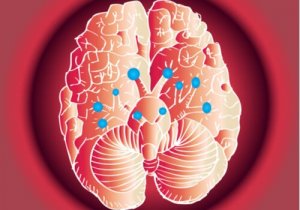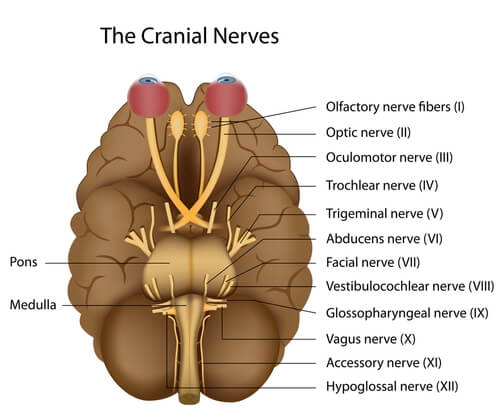Our Amazing Cranial Nerves and How They Work

Cranial nerves are often referred to as cranial nerve pairs. This is simply because they come in pairs, one in each hemisphere of the brain.
The complexity of the nervous system is astounding. Its multiple connections make this system one of the most important ones in our body. In this article, we’re going to talk about one of its most important components: cranial nerves.
Cranial nerves, or nerve pairs, emerge from the base of the skull and reach their target areas through small orifices distributed throughout it. Thus, they communicate with all the peripheral areas. They get the name of “pairs” because there’s a nerve on both sides of the brain. Therefore, there are twelve nerves in the right hemisphere and twelve nerves in the left hemisphere.
Classification of Cranial Nerves
The cranial pairs can be classified in different ways:
According to Their Function
- Motor cranial nerves. Cranial nerves that are related to eye movements (3, 4, and 5), and related to the movements of the tongue and neck (10 and 12).
- Sensory cranial nerves. 1, 2, and 8.
- Mixed cranial nerves. 5, 7, 9, and 10.
- Parasympathetic cranial nerves. 3 and 7.
According to Their Position
There are some located above the brainstem (pairs one and two); others in the upper part of the brainstem (pairs three and four); those near the bridge (pairs five, six, seven, and eight); and, finally, those that are in the lowest part of the medulla oblongata (pairs nine, ten, eleven, and twelve).
According to Bear, Connors, and Paradiso, authors of the book Neuroscience: Exploring the Brain, the first two cranial nerves are part of the central nervous system and the others are like the spinal nerves. They state that this is so “in the sense that they contain axons that belong to the peripheral nervous system”. Each of these nerves has fibers that perform several different functions.

Cranial Nerves and Their Functions
Cranial Pair 1
Types of axons. Special sensory.
This is the shortest cranial pair, since its target area is close to the area it comes from in the brain. It’s also called the olfactory nerve. In addition, as its name indicates, it’s responsible for carrying nervous information related to smell.
Cranial Pair 2
Types of axons. Special sensory.
This nerve originates in the diencephalon. And, like the previous one, it has afferent fibers that transport nerve impulses from the sensory organs to the central nervous system. Its function is to transmit visual information.
Cranial Pair 3
Types of axons. Somatic motor and visceral motor.
This nerve has two other names: the oculomotor nerve or the ocular motor. It’s responsible for the movement of the eyes and eyelids. In addition to this, it deals with the parasympathetic control of the size of the pupils.
Cranial Pair 4
Types of axons. Somatic motor.
This fourth pair originates in the mesencephalon. It goes by the names of the trochlear nerve and the pathetic nerve. It also deals with the movement of the eyes and sends signals to the eye’s superior oblique muscle.
Cranial Pair 5
Types of axons. Somatic sensory and somatic motor.
This is known as the trigeminal nerve and has motor and sensory functions. Firstly, at a motor level, it sends orders to the muscles responsible for chewing. And, in addition, on a sensory level, it also collects tactile, pain, and proprioceptive information from the mouth and face.
Cranial Pair 6
Types of axons, Somatic motor.
This cranial pair is called the abducens nerve. It’s responsible for the abductor movements of the eye and is the one that causes the eye to move towards the opposite side of the nose. Isn’t that incredible?
Cranial Pair 7
Types of axons. Somatic sensory and somatic motor.
This is also known as a facial pair. This is due to the fact that it’s responsible for the movements of the facial expression muscles. In addition to that, it deals with the sense of taste in the upper two-thirds of the tongue. It also sends orders to the lacrimal and salivary glands.
Cranial Pair 8
Types of axons. Special sensory.
This is the vestibulocochlear nerve. It’s in charge of the sense of hearing and balance, receiving information about what we hear and, also, our physical location.
Cranial Pair 9
Types of axons. Somatic motor, visceral motors, special sensory, and visceral sensory.
This is called the glossopharyngeal nerve. It’s a mixed nerve, and, from its name, we can deduce some of its functions:
- Movement of the muscles of the throat.
- Parasympathetic control of the salivary glands.
- Detection of changes in blood pressure in the aorta.
- Sense of taste in the front third of the tongue.

Cranial Pair 10
Types of axons. Visceral motor.
This is called the vagus nerve. It’s responsible for the parasympathetic control of the heart, lungs, and abdominal organs. In addition to that, it transmits the sensation of visceral pain, the movement of the throat muscles, and also receives information regarding taste.
Cranial Pair 11
Types of axons. Somatic motor.
This is called the accessory nerve. It handles throat and neck muscle movements.
Cranial Pair 12
Types of axons. Somatic motor.
Called the hypoglossal nerve, this cranial nerve pair contributes to the action of swallowing. In addition to that, it’s responsible for the movement of the tongue, working together with cranial pairs nine and ten. Thanks to this pair, swallowing is performed optimally.
As you can see, any damage to the cranial nerves can mean serious problems for the functioning of our body and even our survival. Neurological disorders can manifest when this damage occurs in our bodies.
We hope that we’ve helped you understand and appreciate these essential nerves in our brains a lot more!
All cited sources were thoroughly reviewed by our team to ensure their quality, reliability, currency, and validity. The bibliography of this article was considered reliable and of academic or scientific accuracy.
- Bear, M. F. Connors, B. W., PAradiso, M.A. Nuin, X.U., Guillén, X.V & Sol Jaquotor, M.J. (2008). Neurociencias la exploración del cerebro. Wolters Kluwer/Lippicott Williams & Wikins.
- Kandel, E. R., Schwartz, J. H., & Jessel, T.M. (2001). Principios de neurociencia. Madrid: McGrawHill Interamericana.
This text is provided for informational purposes only and does not replace consultation with a professional. If in doubt, consult your specialist.








